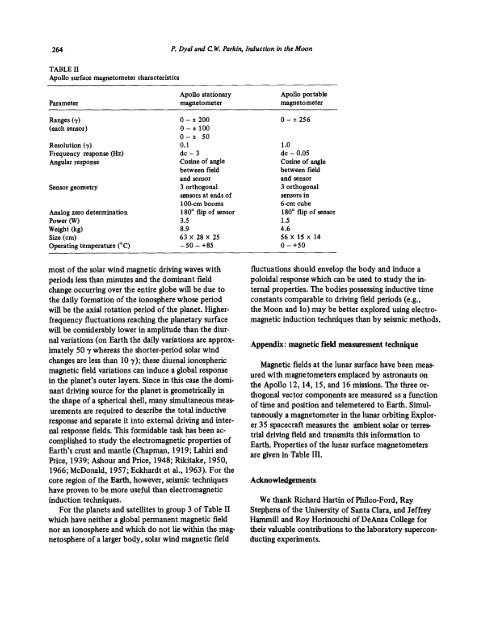global electromagnetic induction in the moon and planets - MTNet
global electromagnetic induction in the moon and planets - MTNet
global electromagnetic induction in the moon and planets - MTNet
You also want an ePaper? Increase the reach of your titles
YUMPU automatically turns print PDFs into web optimized ePapers that Google loves.
264 P. Dyal <strong>and</strong> C.W. Park<strong>in</strong>, Induction <strong>in</strong> <strong>the</strong>Moon<br />
TABLE II<br />
Apollo surfacemagnetometer characteristics<br />
Apollo stationary Apollo portable<br />
Parameter magnetometer magnetometer<br />
Ranges(7) 0 —±200 0—i 256<br />
(each sensor) 0 — ±100<br />
0—i 50<br />
Resolution (~‘) 0.1 1.0<br />
Frequency response (Hz) dc — 3 dc — 0.05<br />
Angular response Cos<strong>in</strong>e of angle Cos<strong>in</strong>e of angle<br />
betweenfield between field<br />
<strong>and</strong> sensor <strong>and</strong> sensor<br />
Sensor geometry 3 orthogonal 3 orthogonal<br />
sensors at ends of sensors <strong>in</strong><br />
100-cm booms 6-cm cube<br />
Analog zero determ<strong>in</strong>ation 180°flip of sensor 180°flip of sensor<br />
Power OW) 3.5 1.5<br />
Weight (kg) 8.9 4.6<br />
Size(cm) 63x28X25 56x15x14<br />
Operat<strong>in</strong>g temperature (‘C) —50 — +85 0 — +50<br />
most of <strong>the</strong> solar w<strong>in</strong>d magnetic driv<strong>in</strong>g waves with fluctuations should envelop <strong>the</strong> body <strong>and</strong> <strong>in</strong>duce a<br />
periods less than m<strong>in</strong>utes <strong>and</strong> <strong>the</strong> dom<strong>in</strong>ant field poloidal responsewhich can be used to study <strong>the</strong> <strong>in</strong>change<br />
occurr<strong>in</strong>g over <strong>the</strong> entire globe will be due to ternal properties. The bodies possess<strong>in</strong>g <strong>in</strong>ductive time<br />
<strong>the</strong> daily formation of <strong>the</strong> ionosphere whose period constants comparable to driv<strong>in</strong>g field periods (e.g.,<br />
wifi be <strong>the</strong> axial rotation period of <strong>the</strong> planet. Higher- <strong>the</strong> Moon <strong>and</strong> 10) may be better explored us<strong>in</strong>g electrofrequency<br />
fluctuations reach<strong>in</strong>g <strong>the</strong> planetary surface<br />
will be considerably lower<strong>in</strong> amplitude than <strong>the</strong> diur-<br />
magnetic <strong><strong>in</strong>duction</strong> techniques than by seismic methods.<br />
nal variations (on Earth <strong>the</strong> daily variations are approximately<br />
50 y whereas <strong>the</strong> shorter-period solar w<strong>in</strong>d<br />
Appendix: magnetic field measurement technique<br />
changes are less than 10 ‘y); <strong>the</strong>se diurnal ionospheric<br />
magnetic field variations can <strong>in</strong>duce a <strong>global</strong> response<br />
Magnetic fields at <strong>the</strong> lunar surface have been meas-<br />
uredwith magnetometers emplaced by astronauts on<br />
<strong>in</strong> <strong>the</strong> planet’s outer layers. S<strong>in</strong>ce <strong>in</strong> this case <strong>the</strong> domi- <strong>the</strong> Apollo 12, 14, 15, <strong>and</strong> 16 missions. The three ornant<br />
driv<strong>in</strong>g source for <strong>the</strong> planet is geometrically <strong>in</strong> thogonal vector components are measured as a function<br />
<strong>the</strong> shape of a spherical shell, many simultaneous meas- of time <strong>and</strong> position <strong>and</strong> telemetered to Earth. Simulurements<br />
are required to describe <strong>the</strong> total <strong>in</strong>ductive taneously a magnetometer <strong>in</strong> <strong>the</strong> lunar orbit<strong>in</strong>g Explorresponse<br />
<strong>and</strong> separate it <strong>in</strong>to external driv<strong>in</strong>g <strong>and</strong> <strong>in</strong>ter- er 35 spacecraft measures <strong>the</strong> ambient solar or terresnal<br />
response fields. This formidable task has been ac- -trial driv<strong>in</strong>g field <strong>and</strong> transmits this <strong>in</strong>formation to<br />
complished to study <strong>the</strong> <strong>electromagnetic</strong>properties of Earth. Properties of <strong>the</strong> lunar surface magnetometers<br />
Earth’s crust <strong>and</strong> mantle (Chapman, 1919; Lahiri <strong>and</strong><br />
Price, 1939; Ashour <strong>and</strong> Price, 1948; Rikitake, 1950,<br />
1966; McDonald, 1957;Eckhardt et al., 1963). For <strong>the</strong><br />
are given <strong>in</strong> Table Ill.<br />
core region of <strong>the</strong> Earth, however, seismic techniques<br />
have provento be more useful than <strong>electromagnetic</strong><br />
Acknowledgements<br />
<strong><strong>in</strong>duction</strong> techniques. We thank Richard Hart<strong>in</strong> of Philco-Ford, Ray<br />
For <strong>the</strong> <strong>planets</strong> <strong>and</strong> satellites <strong>in</strong> group 3 of Table II Stepi~iensof <strong>the</strong> University of Santa Clara, <strong>and</strong> Jeffrey<br />
which have nei<strong>the</strong>r a <strong>global</strong> permanent magnetic field Hammill <strong>and</strong> Roy Hor<strong>in</strong>ouchi of DeAnza College for<br />
nor an ionosphere <strong>and</strong> which do not lie with<strong>in</strong> <strong>the</strong> mag- <strong>the</strong>ir valuable contributions to <strong>the</strong> laboratory superconnetosphere<br />
of a larger body, solar w<strong>in</strong>d magnetic field duct<strong>in</strong>g experiments.

















